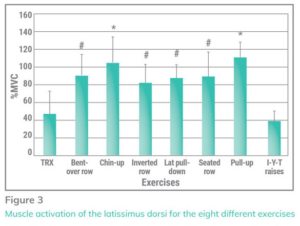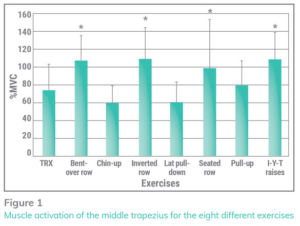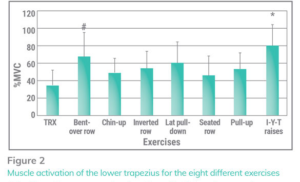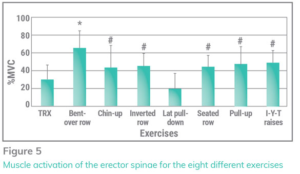BB – BARBELL ROWS
Click on Image to Enlarge
MOMENT ARM & EMG STUDY
LATISSIMUS DORSI MIDDLE REGION, UPPER & LOWER ERECTOR SPINAE
JOINT COMPRESSION, AXIAL TWIST & FLEXION-EXT MUSCULAR STIFFNESS
– Inverted Body Row, Standing 1-Arm Cable Row, BB Row
Comparison of Different Rowing Exercises: Trunk Muscle Activation and Lumbar Spine Motion, Load, and Stiffness – 2009 – Fenwick, McGill
Procedures
– matched the loading between exercises relative to inverted row
Electrode Placement
– Latissimus Dorsi: over the muscle belly when the arm was positioned in the shoulder mid-range
Results
Latissimus Dorsi – Middle: inverted row 80% · standing 1-arm cable row 70% · bent over bb row 55%
+ Upper erector Spinae: inverted row 60% · bent over bb row 50% · standing 1-arm cable row 50%
+ Lower erector Spinae: bent over bb row 40% · inverted row 30% · standing 1-arm cable row 20%
Results – Figure 4 below
Joint Compression: bent over bb row · standing 1-arm cable row · inverted row
– the compromised spine angle and large moment caused by the load in the hand contributed to the high joint compression
Result Figure 5 below
Axial Twist Muscular Stiffness: standing 1-arm cable row · bent over bb row · inverted row
Flexion/Extension Muscular Stiffness: bent-over bb row · inverted row · standing 1-armed cable row
– Due to compromised spine posture and large low back moment, the spine must increase stiffness to maintain its stability
EMG STUDIES
LATISSIMUS DORSI, UPPER-MIDDLE-LOWER TRAPS & BICEPS
– Seated Cable Row, BB Row, Lat Pulldown, Upright Row
EMG of the biceps brachii, latissimus dorsi, and trapezius muscles during 5 pull exercises – 2005 – Handa
Procedure
– compare 5 different pull movements; 8 weight-trained men
Universal Machine Exercises
1. Lat Pulldown: medium pronated grip
2. Bent over Row: medium pronated grip
3. Seated Cable Row: narrow pronated grip
4. Upright Row: medium pronated grip
Results – 3 reps @70%RM
Note: I don’t know where the electrodes were placed for the latissimus dorsi
Trapezius – Upper: upright row 82% · bent over row 78% · seated cable row 42% · lat pulldown 29%
Trapezius – Middle: bent over row 90% · seated cable row 66% · upright row 66% · lat pulldown 48%
Trapezius – Lower: bent over row 87% · upright row 67% · seated cable row 56% · lat pulldown 55%
Latissimus Dorsi: seated cable row 82% · lat pulldown 78% · bent over row 64% · upright row 14%
+ Biceps Brachii: upright row 92% · lat pulldown 64% · bent over row 44% · seated cable row 41%
UPPER LATS, INFRASPINATUS, MIDDLE-LOWER TRAPS & ERECTOR SPINAE
– Seated Cable Row, Inverted Body Row, Prone LYT, BB Row
– Lat Pulldown, Chinup, Pullup
What is the best back exercise? – 2018 – Edelburg – PDF Link to Edelburg Thesis .
Procedure
– 19 males; resistance-trained; 5 reps @70% 1RM or bodywt; rest 2min; exercises performed in random order
Exercises
Lat Pulldown: overhand grip, medium width; pulled shoulder blades down and back; leaning back slightly pulling bar to top of chest and paused
Pullup: shoulder width overhand grip, pulled shoulders back and down, elbows down toward sides, chin level with the bar
Bent-over BB Row: shoulder width overhand grip; pulled toward the sternum keeping a flat back
Inverted Row: straight bar; medium-width grip; shoulder blades retracted at finish
Seated Row: V-bar handle; feet on platform, knees bent, straight back; chest up; pulled until handle touched front of stomach
TRX Row: pulled scapula down and back; elbows tight; palms facing inward; standing with one foot ahead of the other; leaning backward while shifting body weight over back leg; shoulders rolled forward
Prone “I” face down on bench; arms straight overhead; palms facing inward; retracting scapulae
Prone “Y” face down on bench; arms at 45º lifting thumbs toward the ceiling; retracting scapulae
Prone “T” face down on bench; arms at 90º palms facing floor; retracting scapulae
Results MVC
Latissimus dorsi – Upper Fibers – Extension, adduction, horizontal abduction, and internal rotation of the shoulder
· Over 100% – pullup > chinup
· 85% → 82% – bent-over bb row > seated row > lat pulldown > inverted row
· 45% → 40% – TRX > IYT Raises
Infraspinatus – External rotation of the shoulder (this is one of the rotator cuff muscles)
· 58% → 50% – IYT Raises > bent over bb row > pullup > chinup > inverted row
· 40% → 35% – seated row > TRX > lat pulldown
Middle trapezius – Upward rotation and adduction of the scapulae
· Over 100% – IYT Raises > bent over bb row > inverted row > seated row
· 80% → 75% – pullup > TRX
· 60% – chinup > lat pulldown
Lower trapezius – Depression of the scapulae
· 80% –IYT Raises
· 62% → 42% – bent over bb row > lat pulldown > pullup >inverted row > chinup > seated row
· 35% – TRX
+ Erector spinae – Extension and lateral flexion of the spine
· 62% – bent over bb row
· 48% → 40% – IYT Raises > pullup > chinup > inverted row > seated row
· 28% → 20% – TRX > lat pulldown









